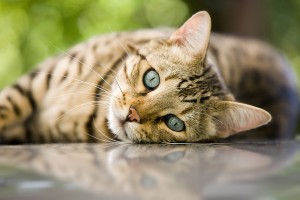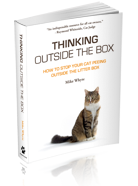If a cat that appears as though it has walked straight out of the wilderness and into civilization is what you want, then the Bengal cat fills that order. The Bengal cat is a hybrid breed produced by crossing the domestic cat with an Asian Leopard cat. The desire of such cross breeding is to produce a cat that looks wild, but has the temperament of a domestic cat.
Physical Body
The most distinct feature of the Bengal cat is its extremely soft, thick, and uniquely patterned coat. There are two distinct patterns recognized within the Bengal cat breed. Those are spotted and marbleized. The spotted coat is closest to its leopard ancestor, featuring leopard spots in varying shades of brown, rust, orange, sand, black, and gray. The marbleized coat is produced from the mixing of the Asian Leopard cat with a domestic tabby to produce splotches that look more like marble. In either case, the Bengal cat has a look that is both strikingly beautiful and wild.
 Other than the coat, another distinguishing feature that sets it apart from other cats is its muscular body, more prominent in males than females. Bengal cats are very athletic, sleek, and muscular.
Other than the coat, another distinguishing feature that sets it apart from other cats is its muscular body, more prominent in males than females. Bengal cats are very athletic, sleek, and muscular.
Temperament
The Bengal cat loves to be part of the family. They love to interact and play. This is not to say they will not seek out a soft chair or lap in which to lie for a nap, but for the majority of the day they are very active cats. Being a high energy cat, they are not for someone looking for a docile animal to lounge around the house and look pretty.
The exotic heritage of this cat makes it unique both in look and personality. Even though it takes five generations of Bengal-to-Bengal breeding to produce a line recognized as a Bengal cat, these felines have a wild ancestral heritage and some of those instincts can still be seen in late generations through their extreme intelligence, high energy, and innate curiosity. This is a cat that loves to play and will demand interaction with their owners but in a way that is most pleasant. Some Bengals can even be trained to walk on a leash and play fetch. It’s also reported by some owners that their Bengals love water and will shower with them.
Due to the wild ancestral line of the Bengal, careful selective breeding practices are implemented by high quality Bengal cat breeders to ensure that the docile temperament of the domesticated ancestors is dominant.
Common Medical Problems
As with any breed of cat or dog, certain medical problems seem to be more commonplace than others. For the Bengal, the most common health problems seen by veterinarians are as follows:
Progressive Retinal Atrophy – This problem eventually causes blindness. There is no way to screen for this problem, so there is no way for a breeder to tell if a kitten will have problems later on.
Cataracts – Thickening and clouding of the eye lens, causing loss of vision over a period of time and eventual blindness. This problem can be reversed since cataract surgery is available for cats.
Cardiomyopathy – This covers both thickening of the heart muscles and thinning of the heart muscles, both causing very poor circulation. Cats stricken with this condition can appear healthy for a very long time and then suddenly appear very ill.
Inflammatory Bowel Disease – This is a condition in which an infection is present within the digestive tract. The symptoms of this condition are typically vomiting and diarrhea. Any Bengal showing symptoms should be taken to the veterinarian immediately to avoid dehydration.
Food Poisoning – Bengals have especially sensitive stomachs. For this reason, their diets should be carefully monitored and table scraps should never be on the menu.
One medical problem you’ll never have to worry about with the Bengal cat and possibly their most fascinating feature is they possess an apparent immunity to feline leukemia. This is an inherited trait that the Bengal cat received from its ancestor the Asian Leopard cat.
Bengal cats are one of the most interesting breeds in existence today. From their wild markings to their playful and loving demeanor, Bengal’s are an absolute joy to have around the house, especially in a household with children. If a cat who acts more like a family member is desired, the Bengal cat is a great choice.

Please contribute to this article discussion and post a comment below...
Powered by Facebook Comments